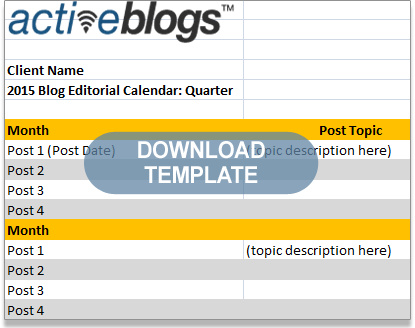What’s the most useful tool a content creator with little time to spare can have in his or her arsenal? An editorial calendar.
A content editorial calendar is an outline of the content you plan on creating over a finite period of time. It organizes your topic ideas and allows you to distribute posts in a well thought-out manner.
Editorial calendars may sound like a lot of work, but they’re really just a redistribution of your time. When you spend more initial time planning out your posts and creating an outline, the writing process becomes much quicker. Having an editorial calendar makes it easier to plan content topics for a blog, newsletter, or other publications.
If you’re not sure how to get started, you’ve come to the right place! Follow a few of our helpful tips that can make implementing an editorial calendar in your content marketing efforts a simple, stress free experience.
How can you plan an editorial calendar?
The first piece of advice? Don’t overthink it. If you’ve never done an editorial calendar before, keeping it simple is best. It should be a list of scheduled topics that can optionally include a short description of the article’s main idea and other campaign-related information (e.g a call to action). Keep in mind an editorial calendar is not an outline or rough draft — focus on the big picture before you dive into more details at a later time.
Use a basic table, such as an Excel spreadsheet, to organize your calendar. The length of the editorial calendar should depend on your content’s frequency. A 3-month editorial calendar may be good for biweekly posts — but for less frequently created content, such as a quarterly newsletter, a year-long calendar is appropriate.
From there, it’s just a matter of brainstorming topics. Pull on your knowledge of the industry, subject, and audience to generate ideas. Also consider your objectives and what stage of the buyer’s journey the content will target. Flesh out your topic ideas with online research or even interviews until you’ve come up with a great idea for a piece of content.
As much as structure can help, remember it is ok to be flexible. Make room for time-sensitive content as it comes up and be willing to switch topics around to make things work.
How can an editorial calendar help?
Content writers rely on editorial calendars for a reason — it helps them create better quality content. But why does it make such a difference?
A huge factor is the amount of time it saves. Coming into each post with a structured topic can greatly decrease the time it takes to turn that idea into quality content. It also inspires higher-level, strategic thinking. Each post can build upon the previous one and ensure an appropriate range of topics are covered for the audience.
An editorial calendar is a simple tool that makes a big difference. Investing time in creating a plan for your content will save you time in the long term and produce better results. So if you’ve been considering implementing an editorial calendar, now is the time to get started!
Download your editorial calendar template today!




